Complete Solutions to (NUMERICALS) of chapter UNIT–III & UNIT–IV MAGNETIC EFFECTS OF CURRENT AND MAGNETISM & E.M.I. AND ALTERNATING CURRENT of Class 12 book with complete answers and questions
| Class 12 | PHYSICS |
| Chapter | UNIT–III & UNIT–IV MAGNETIC EFFECTS OF CURRENT AND MAGNETISM & E.M.I. AND ALTERNATING CURRENT |
| SUPPORT MATERIAL | (NUMERICALS) |
| Number Of Questions | 57 |
| Academic Year | 2023-24 |
An electron travels on a circular path of radius 10 m in a magnetic field of `2 xx 10^(–3)` T. Calculate the speed of electron. What is the potential difference through which it must be accelerated to acquire this speed?
07:43View SolutionA charge particle of mass m and charge q entered into magnetic field B normally after accelerating by potential difference V. Calculate radius of its circular path.
07:35View SolutionCalculate the magnetic field due to a circular coil of 500 turns and of mean diameter 0.1m, carrying a current of 14A (i) at a point on the axis distance 0.12 m from the centre of the coil (ii) at the centre of the coil.
07:58View SolutionAn electron of kinetic energy 10 keV moves perpendicular to the direction of a uniform magnetic field of 0.8 milli tesla. Calculate the time period of rotation of the electron in the magnetic field.
09:28View SolutionIf the current sensitivity of a moving coil galvanometer is increased by 20% and its resistance also increased by 50% then how will the voltage sensitivity of the galvanometer be affected?
View SolutionA uniform wire is bent into one turn circular loop and same wire is again bent in two circular loop. For the same current passed in both the cases compare the magnetic field induction at their centres.
07:36View SolutionA horizontal electrical power line carries a current of 90A from east to west direction. What is the magnitude and direction of magnetic field produced by the power line at a point 1.5 m below it?
View SolutionA galvanometer with a coil of resistance `90Omega` shows full scale deflection for a potential difference 25mV. What should be the value of resistance to convert the galvanometer into a voltmeter of range 0V to 5V. How should it be converted?
View SolutionTwo identical circular loops P and Q carrying equal currents are placed such that their geometrical axis are perpendicular to each other as shown in figure. And the direction of current appear’s anticlockwise as seen from point O which is equidistant from loop P and Q. Find the magnitude and direction of the net magnetic field produced at the p oint O.
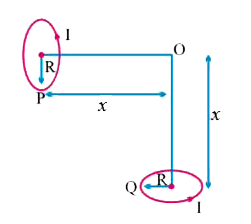
`tan theta = (B_2)/(B_1)=1, theta = pi//4`.09:49View SolutionA cyclotron’s oscillator frequency is 10 MHz. What should be the operating magnetic field for accelerating protons, if the radius of its dees is 60 cm ? What is the kinetic energy of the proton beam produced by the accelerator? Given `e = 1.6 xx 10^(–19) C, m = 1.67 xx 10^(–27)` kg. Express your answer in units of MeV `[1MeV = 1.6 xx 10^(–13) J]`.
View SolutionThe coil of a galvanometer is 0.02 × 0.08 m2. It consists of 200 turns of fine wire and is in a magnetic field of 0.2 tesla. The restoring torque constant of the suspension fibre is `10^(–6)` Nm per degree. Assuming the magnetic field to be radial.
(i) What is the maximum current that can be measured by the galvanometer, if the scale can accommodate `30^@` deflection?
(ii) What is the smallest, current that can be detected if the minimum observable deflection is `0.1^@`?View SolutionA voltmeter reads 5V at full scale deflection and is graded according to its resistance per volt at full scale deflection as `5000OmegaV^(–1)`. How will you convert it into a voltmeter that reads 20V at full scale deflection? Will it still be graded as `5000 OmegaV^(–1)`? Will you prefer this voltmeter to one that is graded as `2000 Omega V^(–1)`?
View SolutionA short bar magnet placed with its axis at 30° with an external field 1000G experiences a torque of 0.02 Nm. (i) What is the magnetic moment of the magnet. (ii) What is the work done in turning it from its most stable equilibrium to most unstable equilibrium position?
View SolutionWhat is the magnitude of the equatorial and axial fields due to a bar magnet of length 4 cm at a distance of 40 cm from its mid point? The magnetic moment of the bar magnet is a 0.5Am`""^2`
View SolutionWhat is the magnitude of magnetic force per unit length on a wire carrying a current of 8A and making an angle of 30° with the direction of a uniform magnetic field of 0.15T?
04:24View SolutionTwo moving coil metres `M_(1) and M_(2)` have the following particular `R_(1) =10Omega, N_(1) =30, A_(1) = 3.6 xx 10^(-3) m^(2), B_(1) =0.25 T,`
`R_(2) = 14Omega , N_(2) =42, A_(2) = 1.8 xx 10^(-3) m^(2), B_(2) =0.50 T`
The spring constants are identical for the two metres. What is the ratio of current sensitivity and voltage sensitivity of `M_(2)" to" M_(1)?`06:43View SolutionFigure shows a small magnetised needle P placed at a point O. The arrow shows the direction of magnetic moment. The other arrows show different positions (and orientations of the magnetic moment) of another identical magnetised needle Q.
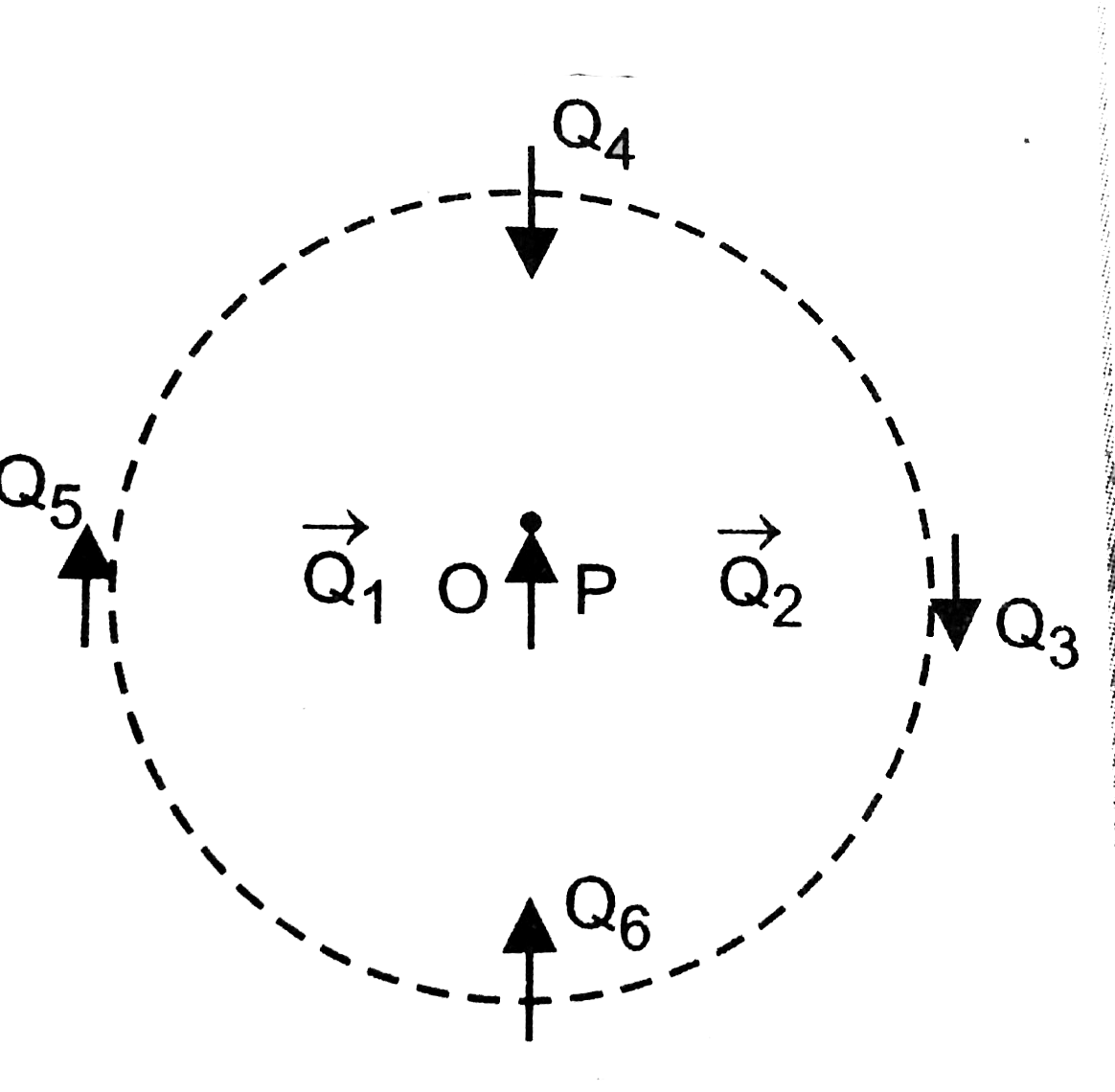
(a) In which configuration is the system not in equilibrium?
(b) In which configuration is the system in (i) stable and (ii) unstable equilibrium?
(c) Which configuration corresponds to the lowest potential energy among all the configurations shown?07:46View SolutionFigure shows a small magnetised needle P placed at a point O. The arrow shows the direction of magnetic moment. The other arrows show different positions (and orientations of the magnetic moment) of another identical magnetised needle Q.

(a) In which configuration is the system not in equilibrium?
(b) In which configuration is the system in (i) stable and (ii) unstable equilibrium?
(c) Which configuration corresponds to the lowest potential energy among all the configurations shown?07:46View SolutionFigure shows a small magnetised needle P placed at a point O. The arrow shows the direction of magnetic moment. The other arrows show different positions (and orientations of the magnetic moment) of another identical magnetised needle Q.

(a) In which configuration is the system not in equilibrium?
(b) In which configuration is the system in (i) stable and (ii) unstable equilibrium?
(c) Which configuration corresponds to the lowest potential energy among all the configurations shown?07:46View SolutionIn the circuit, the current is to be measured. What is the value of the current if the ammeter shown :
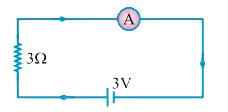
(a) is a galvanometer with a resistance `R_(G) = 60 Omega`,02:46View SolutionIn the circuit shown in figure, the current is to measured. What is the value of the current if the ammeter shown (i) is a galvanometer with a resistance `R_G=60*00Omega`. (ii) is a galvanometer described in (i) but converted to an ammeter by a shunt resistance `r_s=0*02Omega`, (iii) is an ideal ammeter with zero resistance?
 02:22View Solution
02:22View SolutionIn the circuit, the current is to be measured. What is the value of the current if the ammeter shown :
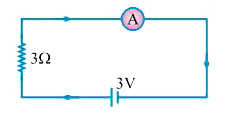
(c) is an ideal ammeter with zero resistance?01:40View SolutionAn element `dvecl=dxhati` (where `dx=1cm`) is placed at the origin and carries a large current `i=10A`. What is the magnetic field on the Y-axis at a distance of `0.5m`?
02:28View SolutionA straight wire of mass 200 g and length 1.5 m carries a current of 2 A. It is suspended in mid-air by a uniform horizontal magnetic field B. What is the magnitude of the magnetic field?
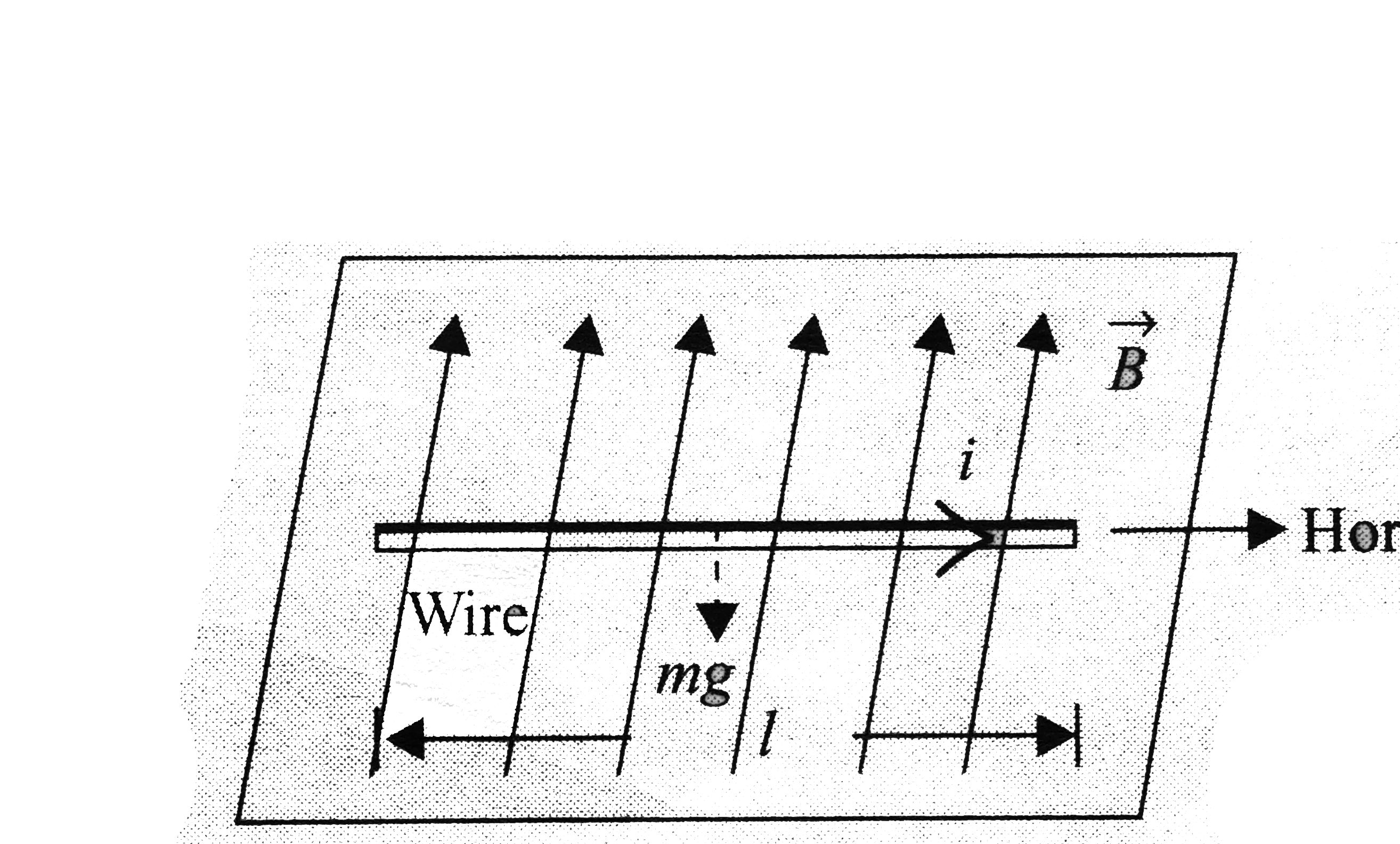 01:28View Solution
01:28View SolutionA rectangular loop of sides 25 cm and 10 cm carrying current of 15A is placed with its longer side parallel to a long straight conductor 2.0 cm apart carrying a current of 25A. What is the new force on the loop ?
View SolutionIn a chamber, a uniform magnetic field of `6*5G(1G=10^-4T)` is maintained. An electron is shot into the field with a speed of `4*8xx10^6ms^-1` normal to the field. (i) Explain why the path of the electron is a circle. Determine the radius of the circular orbit. `(e=1*6xx10^(-19)C, m_e=9*1xx10^(-31)kg)`.
03:37View SolutionIn a chamber, a uniform magnetic field of `6*5G(1G=10^-4T)` is maintained. An electron is shot into the field with a speed of `4*8xx10^6ms^-1` normal to the field. (i) Explain why the path of the electron is a circle. Determine the radius of the circular orbit. `(e=1*6xx10^(-19)C, m_e=9*1xx10^(-31)kg)`.
03:37View SolutionThe horizontal and veritical components of eaths's field at a place ar 0.22 gauss of 0.38 gauss, respectively. Calculate the angle of dip and resultant intensity of earth's field.
03:19View SolutionFollowing figure shows the path of an electron that passes through two regions containing uniform magnetic fields of magnitudes `B_(1)` and `B_(2)` . It's path in each region is a half circle, choose the correct option
 02:47View Solution
02:47View SolutionIn a series C–R circuit, applied voltage is `V = 110 sin 314t` volt. What is the (i) The peak voltage (ii) Average voltage over half cycle ?
View SolutionMagnetic flux linked with each turn of a 25 turns coil is 6 milliweber. The flux is reduced to 1 mWb in 0.5s. Find induced emf in the coil.
03:14View SolutionThe current through an inductive circuit of inductance 4mH is i = 12 cos 300t ampere. Calculate :
(i) Reactance of the circuit.View SolutionThe current through an inductive circuit of inductance 4mH is i = 12 cos 300t ampere. Calculate :
(ii) Peak voltage across the inductor.View SolutionA power transmission line feeds input power at 2400 V to a step down transformer with its primary windings having 4000 turns. What should be the number of turns in the secondary windings in order to get output power at 240 V?
01:14View SolutionThe magnetic flux linked with a closed circuit of resistance `8Omega` varies with time according to the expression `phi = (5t^2 – 4t + 2)` where `phi` is in milliweber and t in second. Calculate the value of induce current at `t = 15 `s.
05:14View SolutionA capacitor, a resistor and 4 H inductor are connected in series to an a.c. source of 50 Hz. Calculate capacitance of capacitor if the current is in phase with voltage.
View SolutionA series C–R circuit consists of a capacitance 16 mF and resistance `8Omega`. If the input a.c. voltage is (200 V, 50 Hz), Calculate (i) voltage across capacitor and resistor. (ii) Phase by which voltage lags/leads current.
View SolutionA rectangular conducting loop of length l and breadth b enters a uniform magnetic field B as shown below.
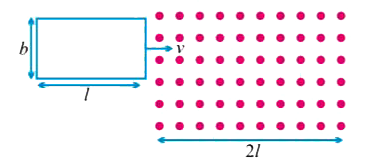
The loop is moving at constant speed v and at t = 0 it just enters the field B. Sketch the following graphs for the time interval t = 0 to `t = (3I)/(v)`.
(i) Magnetic flux versus timeView SolutionA rectangular conducting loop of length l and breadth b enters a uniform magnetic field B as shown below.

The loop is moving at constant speed v and at t = 0 it just enters the field B. Sketch the following graphs for the time interval t = 0 to `t = (3l)/(v)`.
(ii) Induced emf versus timesView SolutionA rectangular conducting loop of length l and breadth b enters a uniform magnetic field B as shown below.

The loop is moving at constant speed v and at t = 0 it just enters the field B. Sketch the following graphs for the time interval t = 0 to `t = (3l)/(v)`.
(iii) Power versus time
Resistance of the loop is R.15:28View SolutionA charged 8mF capacitor having charge 5mC is connected to a 5mH inductor. What is :
(i) the frequency of current oscillations?View SolutionA charged 8mF capacitor having charge 5mC is connected to a 5mH inductor. What is :
(ii) the frequency of electrical energy oscillations in the capacitor?View SolutionA charged 8mF capacitor having charge 5mC is connected to a 5mH inductor. What is :
(iii) the maximum current in the inductor?View SolutionA charged 8mF capacitor having charge 5mC is connected to a 5mH inductor. What is :
iv) the magnetic energy in the inductor at the instant when charge on capacitor is 4mC?View SolutionA `31.4Omega` resistor and 0.1H inductor are connected in series to a 200V, 50Hz ac source. Calculate
(i) the current in the circuit04:11View SolutionA `31.4Omega` resistor and 0.1H inductor are connected in series to a 200V, 50Hz ac source. Calculate
(ii) the voltage (rms) across the inductor and the resistor.06:18View SolutionA `31.4Omega` resistor and 0.1H inductor are connected in series to a 200V, 50Hz ac source. Calculate
(iii) is the algebraic sum of voltages across inductor and resistor more than the source voltage ? If yes, resolve the paradox.View SolutionA squre loop of side a= 12 cm with its sides parallel to x, and y-axis is moved with velocity, V=8 cm/s in the positive x direction in a magnetic field along the positive z-direction. The field is neither uniform in space nor constant in time. It has a gradient `delB//delx=-10^(-3) T//cm` along the x-direction, and it is changing in time at the rate `delB//delt=7T//sec` in the loop if its resistance is R`=4.5 Omega`. Find the current .
05:29View SolutionA square loop of side `12 cm` with its sides parallel to `x` and `y`- axes is moved with a velocity `8 cm//s` along positive `x`-direction in an environment containing magnetic field along `+ve` z-direction. The field has a gradient of `10^(-3) "tesla"//"em"` along `-ve` x-direction (increasing along `-ve` x-axis) and also decreases with time at the rate of `10^(-3) "tesla"//s`. The emf induced in the loop is
06:04View SolutionFigure shows a wire ab of length l which can slide on a U-shaped rail of negligible resistance. The resistance of the wire is R. The wire is pulled to the right with a constant speed v. Draw an equivalent circuit diagram representing the induced emf by a battery. Find the current in the wire.
 06:56View Solution
06:56View SolutionA loop made of straight edegs has six corners at `A(0,0,0), B(L, O,0) C(L,L,0), D(0,L,0) E(0,L,L)` and `F(0,0,L)`. Where `L` is in meter. A magnetic field `B = B_(0)(hat(i) + hat(k))T` is present in the region. The flux passing through the loop `ABCDEFA` (in that order) is
03:48View SolutionA coil of 0.01 henry inductance and 1 ohm resistance is connected to 200 volt, 50 Hz ac supply. Find the impedance of the circuit and time lag between max. alternating voltage and current.
03:24View SolutionAn electrical device draws 2 kW power form AC mains [voltage 223 V (rms) `= sqrt(50,000) V`]. The current differs (lags) in phase by `phi (tan = (-3)/(4))` as compared to voltage. Find (i) R, (ii) `X_(C ) - X_(L)`, and (iii) `I_(M)`. Another device has twice the values for R, `X_(C )` and `X_(L)`. How are the answers affected ?
05:59View SolutionIn a LCR circuit, the plot of `I_("max")` versus ω is shown in figure. Find the bandwith ?
 View Solution
View SolutionAn inductor of unknown value, a capacitor of `100 mu F` and a resistor of 10 ohm are conneted in series to a 200 V, 50 Hz a.c. source It is found that power factor of the circuit is unity. Calculate inductance of the inductor and current amplitude.
03:02View SolutionA 100 turn coil of area `0.1 m^(2)` rotates at half a revolution per second. It is placed in a magnetic field of 0.01 T perpendicular to the axis of rotation of the coil. Calculate the maximum voltage generated in the coil.
02:31View SolutionThe magnetic flux linked with a large circular coil of radius R is `0.5 xx 10^(-3)` Wb, when current of 0.5A flows through a small neighbouring coil of radius r. Calculate the coefficient of mutual inductance for the given pair of coils.
If the current through the small coil suddenly falls to zero, what would be the effect in the larger coil.View Solution
(NUMERICALS) questions and complete solutions for chapter UNIT–III & UNIT–IV MAGNETIC EFFECTS OF CURRENT AND MAGNETISM & E.M.I. AND ALTERNATING CURRENT of CBSE COMPLEMENTARY MATERIAL PHYSICS (HINGLISH) of Class 12
